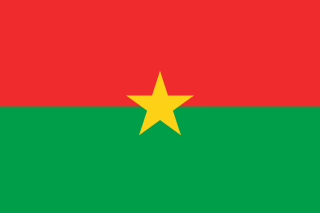
Greenwich Village often referred to by locals as simply "the Village", is a neighborhood on the west side of Manhattan, New York City, within Lower Manhattan. Broadly, Greenwich Village is bounded by 14th Street to the north, Broadway to the east, Houston Street to the south, and the Hudson River to the west. Greenwich Village also contains several subsections, including the West Village west of Seventh Avenue and the Meatpacking District in the northwest corner of Greenwich Village.

A village is a clustered human settlement or community, larger than a hamlet but smaller than a town, with a population ranging from a few hundred to a few thousand. Though villages are often located in rural areas, the term urban village is also applied to certain urban neighborhoods. Villages are normally permanent, with fixed dwellings; however, transient villages can occur. Further, the dwellings of a village are fairly close to one another, not scattered broadly over the landscape, as a dispersed settlement.

Elk Grove Village is a village located in northeastern Illinois adjacent to O'Hare International Airport and is a near northwest suburb, touching the city of Chicago. It is one of the Chicago metropolitan area's principal villages due to its large industrial park, located on the eastern border of the village. The village is located primarily in Cook County with a small portion in DuPage County. The population was 33,127 at the 2010 census. As the name suggests, Elk Grove Village is home to a small herd of elk kept in a grove at the eastern edge of the Busse Woods forest preserve for which the grove is named. Elk are not native to the area but were brought by train from Montana by an early resident, William Busse, in the 1920s. The elk are currently maintained by the Chicago Zoological Society veterinary staff and the Busse Woods Forest Preserve wildlife biologists.
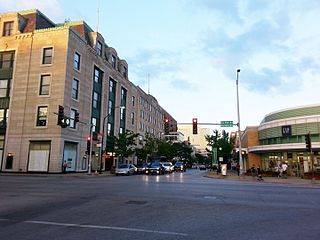
Oak Park is a village adjacent to the West Side of Chicago, Illinois. It is the 29th largest municipality in Illinois as measured by population in the 2010 U.S. census. As of the 2010 United States Census the village had a population of 51,878.

Schaumburg is a village in Cook County and DuPage County in northeastern Illinois, United States. It is a northwestern suburb of Chicago and part of the Golden Corridor. Schaumburg is roughly 28 miles (45 km) northwest of the Chicago Loop and 10 miles (16 km) northwest of O'Hare International Airport. As of the 2010 census, the village had a total population of 74,227. In 2018, the Village of Schaumburg was ranked the Best Place to Live in Illinois by MONEY Magazine. In 2017, Money ranked Schaumburg the 9th best place to live in the United States.
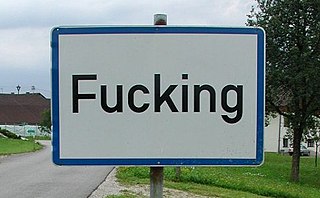
Fucking is an Austrian village in the municipality of Tarsdorf, located in the Innviertel region of western Upper Austria. The village is 33 kilometres (21 mi) north of Salzburg, and is 4 km (2.5 mi) east of the Inn river, which forms the German border.

The Village Voice was an American news and culture paper, known for being the country's first alternative newsweekly. Founded in 1955 by Dan Wolf, Ed Fancher, John Wilcock, and Norman Mailer, the Voice began as a platform for the creative community of New York City. It still is kept alive online.

The East Village is a neighborhood in the New York City borough of Manhattan. It is roughly defined as the neighborhood east of the Bowery and Third Avenue, between 14th Street on the north and Houston Street on the south.
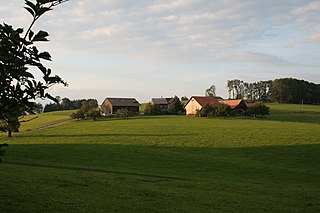
A hamlet is a small human settlement. In different jurisdictions and geographies, hamlets may be the size of a town, village or parish, be considered a smaller settlement or subdivision or satellite entity to a larger settlement. The word and concept of a hamlet have roots in the Anglo-Norman settlement of England, where the old French hamlet came to apply to small human settlements. In British geography, a hamlet is considered smaller than a village and distinctly without a church.

The administrative divisions of New York are the various units of government that provide local government services in the state of New York.

Notre Dame is a census-designated place north of the city of South Bend in St. Joseph County, in the U.S. state of Indiana. It includes the campuses of three colleges: the University of Notre Dame, Saint Mary's College, and Holy Cross College. Notre Dame is split between Clay and Portage Townships. As of the 2010 census, its population was 5,973.
A sarpanch is elected by the village-level constitutional body of local self-government called the Gram Sabha in India. The sarpanch, together with other elected pancha (members), constitute the gram panchayat. The sarpanch is the focal point of contact between government officers and the village community
The administrative divisions of Wisconsin include counties, cities, villages and towns. In Wisconsin, all of these are units of general-purpose local government. There are also a number of special-purpose districts formed to handle regional concerns, such as school districts.
In the United States, the meaning of "village" varies by geographic area and legal jurisdiction. In many areas, "village" is a term, sometimes informal, for a type of administrative division at the local government level. Since the Tenth Amendment to the United States Constitution prohibits the federal government from legislating on local government, the states are free to have political subdivisions called "villages" or not to and to define the word in many ways. Typically, a village is a type of municipality, although it can also be a special district or an unincorporated area. It may or may not be recognized for governmental purposes.

Ditrău is a commune in Harghita County, Romania. It is composed of three villages:

The 28 provinces of Bulgaria are divided into 265 municipalities. Municipalities typically comprise multiple towns, villages and settlements and are governed by a mayor who is elected by popular majority vote for a four-year term, and a municipal council which is elected using proportional representation for a four-year term. The creation of new municipalities requires that they must be created in a territory with a population of at least 6,000 and created around a designated settlement. They must also be named after the settlement that serves as the territory's administrative center, among other criteria.

A Village Development Committee (VDC) in Nepal was the lower administrative part of its Ministry of Federal Affairs and Local Development. Each district had several VDCs, similar to municipalities but with greater public-government interaction and administration. There were 3,157 village development committees in Nepal. Each VDC was further divided into several wards depending on the population of the district; the average being nine wards.

Village People is an American disco group best known for their on-stage costumes, catchy tunes, and suggestive lyrics. The group was originally formed by French producers Jacques Morali, Henri Belolo and lead singer Victor Willis following the release of the debut album, Village People, which targeted disco's gay audience. The group's name refers to New York City's Greenwich Village, at the time known for its large gay population. The characters were a symbolic group of American masculinity and macho gay-fantasy personas.
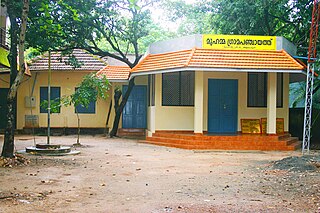
The Panchayat raj is a political system, originating from the Indian subcontinent, found mainly in India, Pakistan, Bangladesh, Sri Lanka, and Nepal. It is the oldest system of local government in the Indian subcontinent, and historical mentions date to the c. 250 CE period. The word raj means "rule" and panchayat means "assembly" (ayat) of five (panch). Traditionally panchayats consisted of wise and respected elders chosen and accepted by the local community. However, there were varying forms of such assemblies. Traditionally, these assemblies settled disputes between individuals and between villages.


